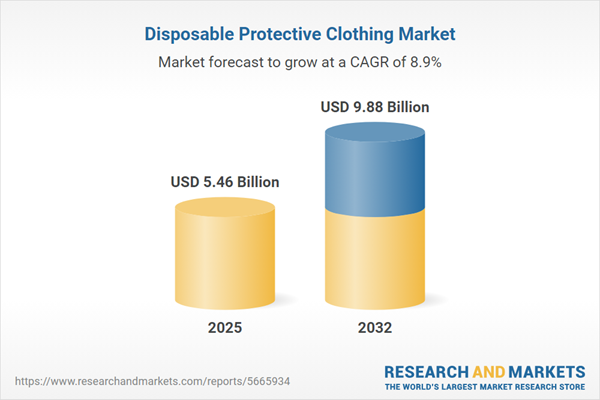Speak directly to the analyst to clarify any post sales queries you may have.
The disposable protective clothing market is entering a phase of significant transformation, shaped by shifts in regulations, global supply chains, and technology adoption. Senior leaders seeking to optimize workplace safety and compliance must understand how this evolving segment drives organizational resilience and productivity.
Market Snapshot: Growth Trajectory and Competitive Dynamics
The disposable protective clothing market grew from USD 5.01 billion in 2024 to USD 5.46 billion in 2025, and is projected to sustain a CAGR of 8.86%, reaching USD 9.88 billion by 2032. The growth reflects broad industry investment in risk mitigation, updated safety regulations, and ongoing innovation in protective materials.
Scope & Segmentation: Comprehensive Coverage for Strategic Planning
- Product Types: Aprons, coveralls, gowns, lab coats, shoe covers, and sleeve covers address protection against chemical splashes, particulates, microbial exposure, and thermal hazards.
- Material Types: Polyethylene and polypropylene for cost-sensitive needs; PVC, SMS, and Tyvek materials for critical barrier requirements and advanced performance in demanding operational environments.
- End User Segments: Chemical and construction industries focus on abrasion resistance and compatibility, food processors on sanitary and disposable design, healthcare on sterile and fluid-repellent garments, oil and gas on flame retardancy, and pharmaceuticals and labs on contamination control.
- Protection Categories: Products engineered for biological, chemical, particulate, and thermal protection, with specialized textile designs to meet industry-specific standards.
- Distribution Channels: Direct sales, distributors (third-party and wholesalers), online platforms (manufacturer websites, third-party e-commerce) span a variety of procurement models to fit different organizational purchasing strategies.
- Regional Insights: Americas, Europe, the Middle East, Africa, and Asia-Pacific markets each contribute unique regulatory, economic, and industrial factors, with growth drivers including stricter safety standards, expanding healthcare infrastructure, and increased manufacturing capacity.
- Technology Integration: Adoption of composite laminates, recyclable and biodegradable materials, RFID tracking, and smart packaging enhances product utility and supply chain efficiency.
- Leading Companies: Competitive landscape features 3M Company, Ansell Limited, Kimberly-Clark Corporation, DuPont de Nemours, Inc., Cardinal Health, Inc., Medline Industries, L.P., Honeywell International Inc., Mölnlycke Health Care AB, Lakeland Industries, Inc., and Alpha Pro Tech, Ltd.
Key Takeaways: Actionable Insights for Senior Decision-Makers
- Heightened regulatory scrutiny is prompting rapid upgrades in testing protocols and product certification, demanding ongoing investment in compliance.
- Innovations in barrier and substrate technologies are enabling improved wearer comfort and meeting niche performance needs across sectors.
- Manufacturers are diversifying raw material sources and regional production hubs to minimize operational risk and address supply chain instability.
- Digital advancements in monitoring and inventory management are reducing inefficiencies and enhancing traceability in procurement cycles.
- Sustainability considerations are reshaping product portfolios, with growing preference for eco-friendly materials and circular economy practices.
Tariff Impact: Navigating Cost Pressures in a Shifting Landscape
Recent United States tariff adjustments on raw materials and finished goods have altered cost structures for disposable protective clothing, particularly affecting items made from polyethylene, polypropylene films, SMS, and Tyvek. In response, firms are exploring alternative sourcing regions, renegotiating supplier contracts, and relocating select production to areas with favorable duty rates. This shift requires a nuanced analysis of lead times and quality consistency, emphasizing the importance of agile procurement and scenario planning for cost management.
Methodology & Data Sources: Ensuring Depth and Credibility
This report leverages extensive secondary research, validated by direct interviews with executives, product innovators, procurement managers, and regulatory leaders across key markets. Each data point is triangulated through multiple sources and statistical correlation, ensuring objectivity and reliability. All processes adhere to industry best practices and strict confidentiality standards.
Why This Report Matters: Strategic Value for Industry Leaders
- Equips senior executives with actionable intelligence on regulatory trends, technology advances, and supply chain risks inherent to the disposable protective clothing sector.
- Enables effective segmentation, product positioning, and channel optimization to capture growth in target regions and industries.
- Informs investment decisions by highlighting innovation levers and sustainability benchmarks shaping the evolving competitive landscape.
Conclusion
Staying ahead in the disposable protective clothing market requires real-time insights into regulatory change, material science, and global demand signals. This report offers the guidance needed for operational resilience and growth as workplace safety standards continue to evolve.
Additional Product Information:
- Purchase of this report includes 1 year online access with quarterly updates.
- This report can be updated on request. Please contact our Customer Experience team using the Ask a Question widget on our website.
Table of Contents
3. Executive Summary
4. Market Overview
7. Cumulative Impact of Artificial Intelligence 2025
Companies Mentioned
The companies profiled in this Disposable Protective Clothing market report include:- 3M Company
- Ansell Limited
- Kimberly-Clark Corporation
- DuPont de Nemours, Inc.
- Cardinal Health, Inc.
- Medline Industries, L.P.
- Honeywell International Inc.
- Mölnlycke Health Care AB
- Lakeland Industries, Inc.
- Alpha Pro Tech, Ltd.
Table Information
| Report Attribute | Details |
|---|---|
| No. of Pages | 198 |
| Published | November 2025 |
| Forecast Period | 2025 - 2032 |
| Estimated Market Value ( USD | $ 5.46 Billion |
| Forecasted Market Value ( USD | $ 9.88 Billion |
| Compound Annual Growth Rate | 8.8% |
| Regions Covered | Global |
| No. of Companies Mentioned | 11 |









